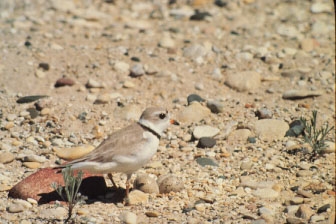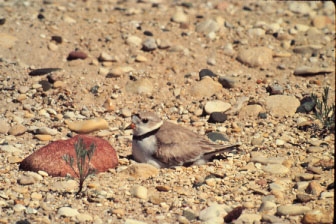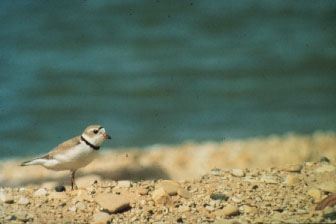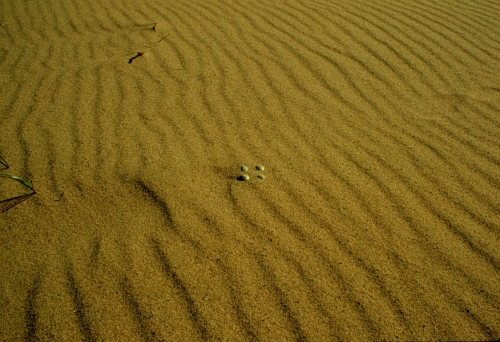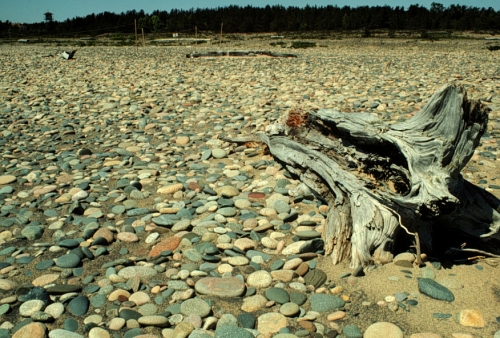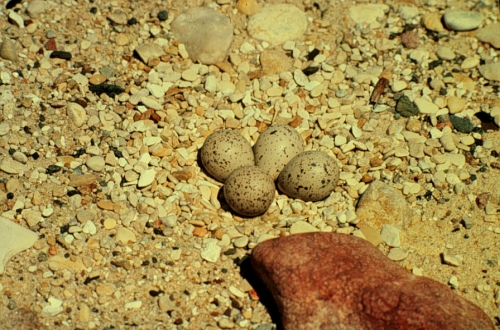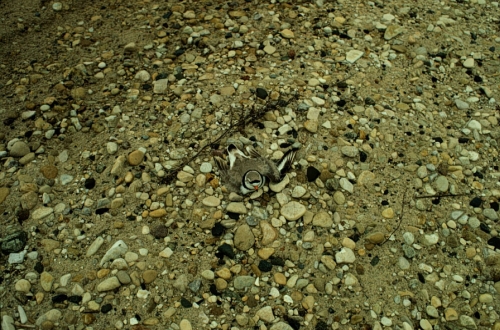Plants and Animals
Charadrius melodus Piping plover
Key Characteristics
The Piping plover is a small compact robin-sized shorebird approximately 7¼” (18 cm) in length with a wing span measuring about 15” (38 cm) and a weight ranging from 1.5-2.2 oz (43-63 grams). It has a very short and stout bill, and very pale upperparts (the color of dry sand). The plover’s sand colored plumage provides an effective camouflage in its preferred beach habitat. During the breeding season the single narrow black band across the upper chest (sometimes incomplete), smaller black band across the forehead, orange-yellow legs and orange bill with a black tip are distinctive. Piping Plovers can also be recognized by their distinctive two-noted, “peep-lo”, melodious whistle.
Status and Rank
US Status: LE - Listed Endangered
State Status: E - Endangered (legally protected)
Global Rank: G3 - Vulnerable
State Rank: S2 - Imperiled
Occurrences
| County | Number of Occurrences | Year Last Observed |
|---|---|---|
| Alger | 2 | 2019 |
| Alpena | 1 | 2003 |
| Bay | 1 | 2010 |
| Benzie | 2 | 2019 |
| Berrien | 1 | 1980 |
| Charlevoix | 8 | 2019 |
| Cheboygan | 1 | 2000 |
| Chippewa | 3 | 2019 |
| Delta | 2 | 2009 |
| Emmet | 10 | 2019 |
| Huron | 1 | 1982 |
| Iosco | 3 | 2015 |
| Leelanau | 8 | 2019 |
| Luce | 4 | 1991 |
| Mackinac | 2 | 2015 |
| Manistee | 1 | 2015 |
| Mason | 3 | 2020 |
| Muskegon | 1 | 2019 |
| Oceana | 1 | 2019 |
| Schoolcraft | 2 | 2019 |
Information is summarized from MNFI's database of rare species and community occurrences. Data may not reflect true distribution since much of the state has not been thoroughly surveyed.
Habitat
Habitat for the plover consists of wide, flat, open, sandy beach with sparse vegetation and scattered cobble. Nesting territories often include a variety of micro-habitats such as seeps, interdunal wetlands, and small creeks.
Natural Community Types
For each species, lists of natural communities were derived from review of the nearly 6,500 element occurrences in the MNFI database, in addition to herbarium label data for some taxa. In most cases, at least one specimen record exists for each listed natural community. For certain taxa, especially poorly collected or extirpated species of prairie and savanna habitats, natural community lists were derived from inferences from collection sites and habitat preferences in immediately adjacent states (particularly Indiana and Illinois). Natural communities are not listed for those species documented only from altered or ruderal habitats in Michigan, especially for taxa that occur in a variety of habitats outside of the state.
Natural communities are not listed in order of frequency of occurrence, but are rather derived from the full set of natural communities, organized by Ecological Group. In many cases, the general habitat descriptions should provide greater clarity and direction to the surveyor. In future versions of the Rare Species Explorer, we hope to incorporate natural community fidelity ranks for each taxon.
Management Recommendations
Habitat destruction, habitat alteration and human development of shorelines has resulted in the extirpation of Piping plovers from most formerly occupied Great Lakes states. Marina construction, inlet dredging, and artificial structures such as breakwalls, can eliminate breeding areas and disrupt natural processes that maintain shoreline habitats. Local planning and zoning boards can address this problem by incorporating shoreline protection and Piping plover habitat needs into land use plans and permitting processes. It is very important to protect current and historical nesting habitat, as well as potential breeding sites to allow population growth and to support the population in the future. Predator exclosures have been used consistently around plover nests since 1988 to protect plover eggs from predation and have increased hatching success significantly. Captive rearing of orphaned Piping plover chicks and abandoned eggs has been implemented since 1992 and resulted in the successful release of fledglings that otherwise would not have survived. Increased use of the shoreline by recreationists often causes parent birds to be frightened away from nests during critical periods of incubation, and the camouflaged eggs or young are easily trampled. A program was initiated in 1994 to organize volunteers to patrol and protect plover nesting areas over holiday weekends since Memorial Day and the Fourth of July coincide with peak egg laying and hatching of Piping plovers. The use of motorized vehicles on the beach, beach walking, bike riding, kite flying, fireworks, bonfires, horseback riding, and camping have been observed to disturb Piping plovers and disrupt normal behavior patterns. Pedestrians accompanied by their pets result in an even greater disturbance to breeding plovers as dogs frequently chase adults and chicks. Landowners are encouraged to assist plovers by keeping their dogs leashed in areas where plovers are nesting. Psychological fencing, which consists of bailing twine and "Unlawful to Enter" and/or "Closed Area" signs, and the use of predator exclosures have been successful in limiting human activity in the vicinity of plover nests and have increased hatching success nearly two-fold.
Active Period
Migration from third week of April to fourth week of April
Migration from third week of July to second week of September
Nesting from fourth week of April to third week of July
Survey Methods
Although Piping plovers can be seen in Michigan from late April through August, the optimal time to survey for Piping plovers is during May and June. Surveys are best done by simply walking the shoreline with binoculars and spotting scopes and looking for adults in courtship displays and foraging at the waters edge. Plovers on the nest that go undetected from afar will exhibit the "broken wing" distraction display when approached too closely. The surveyor(s) should leave the area immediately to avoid attracting predators and allow the adult to return to the nest. Piping plovers are active throughout the day but by limiting surveys to the mid to late morning period the chance of eggs failing as a result of cooling or overheating is reduced.
Shoreline spotting
Survey Period: From first week of May to fourth week of June
Time of Day: Morning (after sunrise)
References
Survey References
- Bibby, C.J., N.D. Burgess, and D.A. Hill. 1992. Bird Census Techniques. Academic Press, New York.
Technical References
- Evers, D.C. 1994. Endangered and Threatened Wildlife of Michigan. The University of Michigan Press, Ann Arbor. 412pp.
- Hyde, D.A. 1999. Special Animal Abstract for Charadrius melodus (Piping plover). Michigan Natural Features Inventory, Lansing, MI. 4pp.
- Hyde, D.A. 1999. Special Animal Abstract for Charadrius melodus (Piping plover). Michigan Natural Features Inventory, Lansing, MI. 4pp.


